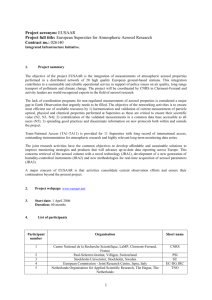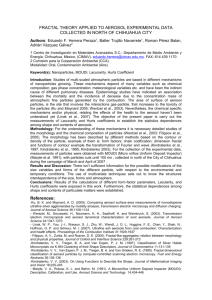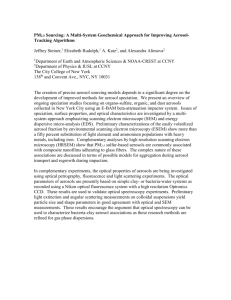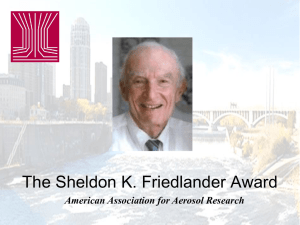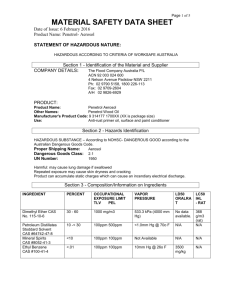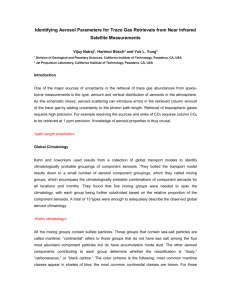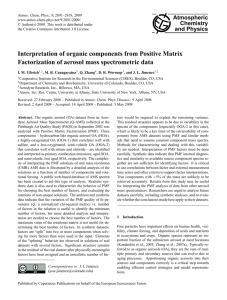jgrd52289-sup-0001-supinfo
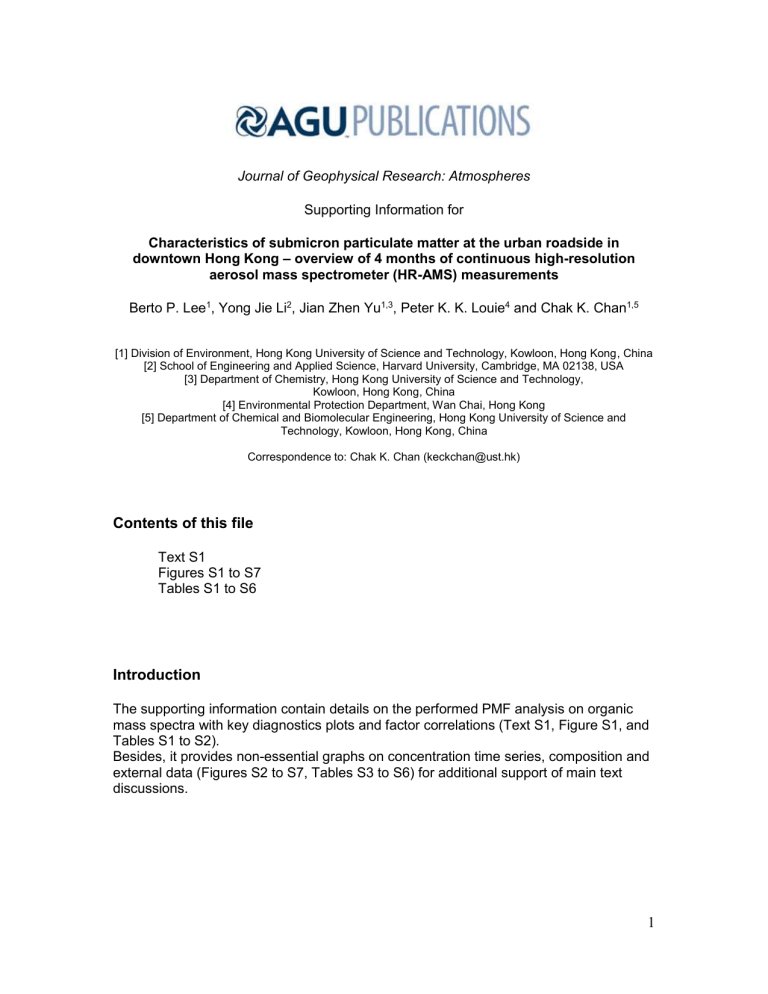
Journal of Geophysical Research: Atmospheres
Supporting Information for
Characteristics of submicron particulate matter at the urban roadside in downtown Hong Kong – overview of 4 months of continuous high-resolution aerosol mass spectrometer (HR-AMS) measurements
Berto P. Lee 1 , Yong Jie Li 2 , Jian Zhen Yu 1,3 , Peter K. K. Louie 4 and Chak K. Chan 1,5
[1] Division of Environment, Hong Kong University of Science and Technology, Kowloon, Hong Kong, China
[2] School of Engineering and Applied Science, Harvard University, Cambridge, MA 02138, USA
[3] Department of Chemistry, Hong Kong University of Science and Technology,
Kowloon, Hong Kong, China
[4] Environmental Protection Department, Wan Chai, Hong Kong
[5] Department of Chemical and Biomolecular Engineering, Hong Kong University of Science and
Technology, Kowloon, Hong Kong, China
Correspondence to: Chak K. Chan (keckchan@ust.hk)
Contents of this file
Text S1
Figures S1 to S7
Tables S1 to S6
Introduction
The supporting information contain details on the performed PMF analysis on organic mass spectra with key diagnostics plots and factor correlations (Text S1, Figure S1, and
Tables S1 to S2).
Besides, it provides non-essential graphs on concentration time series, composition and external data (Figures S2 to S7, Tables S3 to S6) for additional support of main text discussions.
1
Text S1.
PMF Analysis
For the analysis of the Organic Aerosol mass spectra by PMF, the recommended PMF guidelines for AMS data [Zhang et al., 2011] were used. PMF was performed on highresolution mass spectra in exploration with the number of factors ranging from 1 to 10, randomly chosen Seed values and an FPeak Range from -2 to 2 with 0.2 step changes.
Another set was run with a fixed FPeak value of 0 and varying Seed values from 0 to 200 in intervals of 10. As expected, the seed values did not have a notable effect on the observed Q/Qexp ratio.
Due to the similarities in both time series and chemical characteristics of aerosol sources at the urban Mong Kok site, low factor numbers tended to not resolve individual components well enough and thus a “top-down“ approach was taken. The maximum number of 10 factors was chosen as the final solution, with FPeak=0 and Seed=0 where the value of Q/Qexp was at a minimum. Resolved factors with high correlations in terms of either time series or mass spectra (or both) were lumped back together (Tables AT1-
2).Time series were directly added up, while mass spectra were summed according to their average mass contributions to the total of the final factor. The PMF diagnostics plots are depicted in Figure S1.
2
Figure S1.
Summary of key diagnostic plots for the 10 factor solution of the PMF analysis on the W-mode OA spectra
(a) Individual factor mass spectra
(b) Individual diurnal variation
(c) Individual factor time series
(d) Q/Q exp
as a function of number of factors (P) selected for PMF modeling
(e) Q/Q exp
as a function of FPEAK for the 10 factor solution
(f) Fractions of OA factors vs. FPEAK
(g) box and whiskers plot showing the distributions of scaled residuals for each m/z
(h) time series of the measured organic mass and the reconstructed organic mass
(i) time series of the measured and reconstructed residual of the fit
(j) Q/Q exp
values for each m/z
(k) Q/Q exp
for each point in time
(l) Q/Q exp
as a function of SEED values for the 10 factor solution
3
Figure S2.
Location map of Mong Kok (large map) and Civic Triangle (inset)
4
Figure S3. a) Mean concentrations of criteria pollutants from EPD operated general air quality monitoring sites (AQMS) during the first half of the campaign (spring, in red) and the second half of the campaign (summer, in green), median represented by black dot b) Mean concentrations of criteria pollutants from EPD operated roadside air quality monitoring sites (AQMS) during the first half of the campaign (spring, in red) and the second half of the campaign (summer, in green), median represented by black dot
5
8
6
4
12
10
16
14
Orthogonal Distance Regression (ODR)
Coefficient values ± one standard deviation
Intercept
Slope
=
=
1.71 ± 0.10
0.86 ± 0.02
2
0
0 2 4 6 8 10 12 14 16
EC in PM2.5 (µg/m
3
)
Figure S4.
Comparison of simultaneous aethalometer (BC in PM2.5) and ECOC analyzer measurements (EC in PM
2.5
) between June and July 2013
10 10 4
8 8
3
6 6
2
4 4
2 2
June- July 2013
HOA
EC
BC
1
0 0 0
00:00 06:00 12:00 18:00 24:00 00:00 06:00 12:00 18:00 24:00 00:00 06:00 12:00 18:00 24:00
Diurnal Hour Diurnal Hour Diurnal Hour
Figure S5.
Comparison of diurnal variations from simultaneous aethalometer
(BC in PM
2.5
), ECOC analyzer (EC in PM
2.5
) and AMS measurements (HOA from
HR-PMF) between June and July 2013
6
Figure S6. Box (25th, 75th percentile, median as line in box, mean as dot) and whiskers (10th, 90th percentile) plot of AMS main species and organic aerosol species on individual days of the week during a) springtime (7-Mar to 15-May, top panel) b) summertime (16-May to 19-July, bottom panel)
7
8
Figure S7. a) Variation of AMS species concentrations ( left , mean as line with superimposed
SD, median as dot) pie charts of average composition ( middle, right ) during nighttime (1am to 5am) and daytime (5am to 1am) in spring (7-Mar to 15-May) b) Variation of AMS species concentrations ( left , mean as line with superimposed
SD, median as dot) pie charts of average composition ( middle, right ) during nighttime (1am to 5am) and daytime (5am to 1am) in summer (16-May to 19-
July) c) Variation of organic aerosol species concentrations ( left , mean as line with superimposed SD, median as dot) pie charts of average composition ( middle, right ) during nighttime (1am to 5am) and daytime (5am to 1am) in spring (7-Mar to 15-May) d) Variation of organic aerosol species concentrations ( left , mean as line with superimposed SD, median as dot) pie charts of average composition ( middle, right ) during nighttime (1am to 5am) and daytime (5am to 1am) in summer (16-
May to 19-July)
9
Table S1.
Correlation (R
UC
) between factor mass spectra (HR summed to UMR)
color code: R
UC
<0.3, 0.3≤R
UC
≤0.5 0.5<R
UC
<0.7
, R
UC
≥0.7
LV1_1
LV1_2
LV1_1 LV1_2 MO1_1 LO1_1 COA2_1 COA1_1 COA1_2 HOA1_1 HOA1_2 HOA1_3
1.00
0.14
0.14
1.00
0.51
0.42
0.71
0.33
0.23
0.18
-0.02
-0.21
0.08
0.12
0.17
0.07
0.19
0.34
-0.04
0.16
MO1_1
LO1_1
0.51
0.71
COA2_1 0.23
COA1_1 -0.02
COA1_2 0.08
HOA1_1 0.17
HOA1_2 0.19
HOA1_3 -0.04
0.42
0.33
0.18
-0.21
0.12
0.07
0.34
0.16
1.00
0.59
0.47
-0.10
0.30
0.24
0.49
0.05
0.59
1.00
0.38
-0.05
0.34
0.33
0.45
0.09
0.47
0.38
1.00
-0.16
0.36
0.46
0.57
0.35
-0.10
-0.05
-0.16
1.00
0.24
0.21
-0.14
0.00
0.30
0.34
0.36
0.24
1.00
0.54
0.60
0.15
0.24
0.33
0.46
0.21
0.54
1.00
0.47
0.30
0.49
0.45
0.57
-0.14
0.60
0.47
1.00
0.38
0.05
0.09
0.35
0.00
0.15
0.30
0.38
1.00
Table S2.
Correlation (R
PR
) between factor time series color code: R
PR
<0.5, 0.5<R
PR
<0.7
, R
PR
≥0.7
LV1_1 LV1_2 MO1_1 LO1_1 COA2_1 COA1_1 COA1_2 HOA1_1 HOA1_2 HOA1_3
LV1_1
LV1_2
1.00
0.98
0.98
1.00
0.71
0.70
0.20
0.23
-0.02
0.09
0.30
0.43
-0.06
0.06
-0.15
-0.06
0.07
0.17
-0.09
-0.03
MO1_1 0.71
LO1_1 0.20
COA2_1 -0.02
COA1_1 0.30
COA1_2 -0.06
HOA1_1 -0.15
HOA1_2 0.07
HOA1_3 -0.09
0.70
0.23
0.09
0.43
0.06
-0.06
0.17
-0.03
1.00
0.79
0.17
0.42
0.16
0.06
0.21
0.05
0.79
1.00
0.29
0.37
0.27
0.11
0.18
0.03
0.17
0.29
1.00
0.56
0.63
0.38
0.47
0.39
0.42
0.37
0.56
1.00
0.80
0.66
0.68
0.55
0.16
0.27
0.63
0.80
1.00
0.78
0.74
0.74
0.06
0.11
0.38
0.66
0.78
1.00
0.90
0.96
0.21
0.18
0.47
0.68
0.74
0.90
1.00
0.90
0.05
0.03
0.39
0.55
0.74
0.96
0.90
1.00
10
Table S3.
Overview of notable AMS sampling campaigns sorted by world area, country and location type, with overall total NR-PM
1
concentrations, based on
Zhang et al. (2007) and references therein – additional references indicated below
Country City/Place
Location type
Total
Conc.
Country City/Place
Location type
Total
Conc.
Country City/Place Location type
Total
Conc.
Canada
Nova
Scotia
Rural /
Remote
3
Canada Vancouver Urban 7
Finland
1 France
Hyytiala
Paris
Rural /
Remote
2-3
Suburban /
Urban
5
3 China Kaiping
Rural /
Downwind
33
4,5,6 China
Hong
Kong
Suburban /
Urban
15
USA
Storm
Peak, CO
USA
Pittsburgh,
PA
Rural /
Remote
USA
USA
Duke
Forest,
NC
Pinnacle
State Park,
NY
Rural /
Remote
Rural /
Remote
Urban
2
3
12
15
USA
Riverside,
CA
Urban 19
Germany Mainz Urban 4
Germany Hohenpeissenberg
Urban
Downwind
7
Germany
Forested site near
Frankfurt
Urban
Downwind
16
Ireland
2 Spain
Mace Head
Barcelona
Rural /
Remote
2
Suburban /
Urban
19
7,8 China Beijing Urban 71-80
9 China
Beijing,
Olympics
Urban 63
10 China Shenzhen Urban 45
11 China
Shanghai,
EXPO
Urban 29
Japan
Fukue
Island
Rural /
Remote
11-15
USA
Houston,
TX
Urban 13 Switzerland Jungfraujoch
Rural /
Remote
2 Japan
Okinawa
Island
Rural /
Remote
8-15
USA
New York
City
Urban 12
USA
Cruise track along East
Downwind coast of
Urban
USA
8-9
Mexico
Mexico
City
Urban 31
UK
UK
UK
Edinburgh
Manchester
Urban 3
Urban 5-14
~ 30 mi NE of
London
Urban
Downwind
5
Japan Tokyo Urban 13-16
Korea
Cheju
Island
Rural /
Remote
11
UK
North Norfolk coastline near
Weybourne
Urban
Downwind
8
1
2
3
4
5
6
7
8
9
10
11
All other data from Supporting Material from [ Zhang et al.
, 2011] with references cited therein
11
Table S4.
Correlation of HOA components, total HOA and EC with various VOC species for the entire sampling period (March to July)
WHOLE CAMPAIGN HOA1_1 HOA1_2 HOA1_3 HOA EC
Benzene
Toluene
Ethylbenzene o-Xylene
1,2,4-TMB i-Pentane
0.24
0.36
0.18
0.23
0.17
0.34
0.31
0.38
0.26
0.27
0.11
0.50
0.16
0.32
0.28
0.28
0.29
0.62
0.26
0.43
0.33
0.34
0.32
0.66
0.35
0.52
0.44
0.55
0.74
0.47 n-Pentane 0.40 0.51 0.60 0.67 0.53
EC 0.56
0.38 0.59
Pearsons R, color code: R<0.5, 0.5≤R<0.7
, R≥0.7
0.68 1.00
Table S5.
Correlation of HOA components, total HOA and EC with various VOC species for springtime only
SPRING HOA1_1 HOA1_2 HOA1_3 HOA EC
Benzene 0.17
Toluene 0.29
Ethylbenzene 0.07 o-Xylene 0.03
0.26
0.32
0.16
0.05
0.05
0.23
0.21
0.27
1,2,4-TMB i-Pentane
0.14
0.28
0.17
0.40
0.20
0.63 n-Pentane 0.32 0.44 0.58
EC 0.47 0.58
0.64
Pearsons R, color code: R<0.5,
0.5≤R<0.7
,
R≥0.7
0.13
0.32
0.22
0.25
0.26
0.65
0.63
0.74
0.37
0.56
0.46
0.51
0.49
0.53
0.54
1.00
12
Table S6.
Correlation of HOA components, total HOA and EC with various VOC species for summertime only
SUMMER HOA1_1 HOA1_2 HOA1_3 HOA EC
Benzene
Toluene
0.35
0.47
Ethylbenzene 0.48 o-Xylene
1,2,4-TMB i-Pentane
0.60
0.56
0.48
-0.04
0.30
0.47
0.49
0.52
0.70
0.24
0.49
0.50
0.53
0.54
0.53 n-Pentane 0.55 0.66
0.60
EC 0.65 0.27 0.73
Pearsons R, color code: R<0.5, 0.5≤R<0.7
, R≥0.7
0.31
0.54
0.58
0.69
0.62
0.66
0.64
0.76
0.27
0.48
0.43
0.39
0.46
0.40
0.50
1.00
References
Crippa, M., et al. (2013), Wintertime aerosol chemical composition and source apportionment of the organic fraction in the metropolitan area of Paris, Atmos.
Chem. Phys.
, 13 (2), 961-981.
He, L. Y., X. F. Huang, L. Xue, M. Hu, Y. Lin, J. Zheng, R. Y. Zhang, and Y. H.
Zhang (2011), Submicron aerosol analysis and organic source apportionment in an urban atmosphere in Pearl River Delta of China using high-resolution aerosol mass spectrometry, Journal of Geophysical Research-Atmospheres , 116 .
Huang, X. F., L. Y. He, L. Xue, T. L. Sun, L. W. Zeng, Z. H. Gong, M. Hu, and T.
Zhu (2012), Highly time-resolved chemical characterization of atmospheric fine particles during 2010 Shanghai World Expo, Atmos. Chem. Phys.
, 12 (11), 4897-
4907.
Huang, X. F., et al. (2010), Highly time-resolved chemical characterization of atmospheric submicron particles during 2008 Beijing Olympic Games using an
Aerodyne High-Resolution Aerosol Mass Spectrometer, Atmospheric Chemistry and Physics , 10 (18), 8933-8945.
Huang, X. F., et al. (2011), Characterization of submicron aerosols at a rural site in Pearl River Delta of China using an Aerodyne High-Resolution Aerosol Mass
Spectrometer, Atmospheric Chemistry and Physics , 11 (5), 1865-1877.
Lee, B. P., Y. J. Li, J. Z. Yu, P. K. K. Louie, and C. K. Chan (2013), Physical and chemical characterization of ambient aerosol by HR-ToF-AMS at a suburban site in Hong Kong during springtime 2011, Journal of Geophysical Research:
Atmospheres , 118 (15), 8625-8639.
13
Li, Y. J., B. Y. L. Lee, J. Z. Yu, N. L. Ng, and C. K. Chan (2013), Evaluating the degree of oxygenation of organic aerosol during foggy and hazy days in Hong
Kong using high-resolution time-of-flight aerosol mass spectrometry (HR-ToF-
AMS), Atmos. Chem. Phys.
, 13 (17), 8739-8753.
Li, Y. J., B. P. Lee, L. Su, J. C. H. Fung, and C. K. Chan (2015), Seasonal characteristics of fine particulate matter (PM) based on high resolution time-offlight aerosol mass spectrometric (HR-ToF-AMS) measurements at the HKUST
Supersite in Hong Kong, Atmos. Chem. Phys.
, 15 (15), 37-53.
Mohr, C., et al. (2012), Identification and quantification of organic aerosol from cooking and other sources in Barcelona using aerosol mass spectrometer data,
Atmos. Chem. Phys.
, 12 (4), 1649-1665.
Sun, J. Y., Q. Zhang, M. R. Canagaratna, Y. M. Zhang, N. L. Ng, Y. L. Sun, J. T.
Jayne, X. C. Zhang, X. Y. Zhang, and D. R. Worsnop (2010), Highly time- and sizeresolved characterization of submicron aerosol particles in Beijing using an
Aerodyne Aerosol Mass Spectrometer, Atmospheric Environment , 44 (1), 131-140.
Takegawa, N., et al. (2009), Performance of an Aerodyne Aerosol Mass
Spectrometer (AMS) during Intensive Campaigns in China in the Summer of 2006,
Aerosol Science and Technology , 43 (3), 189-204.
Zhang, Q., J. L. Jimenez, M. R. Canagaratna, I. M. Ulbrich, N. L. Ng, D. R.
Worsnop, and Y. L. Sun (2011), Understanding atmospheric organic aerosols via factor analysis of aerosol mass spectrometry: a review, Analytical and
Bioanalytical Chemistry , 401 (10), 3045-3067.
14
